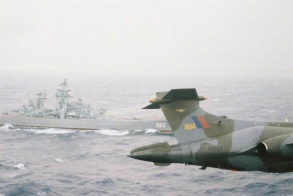





Blue Parrot (2)

So what was it like to work with the Blue Parrot on the Front Line? In researching this piece, I reviewed my logbook for reliability issues: I kept reasonably detailed notes. Pleasingly, and not surprisingly, I was only able to identify one occasion where I could consider the radar as impacting on the achievement of sortie objectives: the incident related to ‘fumes in the cockpit’, which were subsequently attributed to the radar controller overheating. To be honest, I only recall it in detail as I was sent to the medical centre on landing for a blood test, which was never a favoured pastime!
Unlike many Airborne Intercept Radars, such as the Lightning AI23, where finding the target was often described using torch beam or drinking straw analogies, finding potential maritime targets was easy using the ARI 5930; it could pick out warships, large merchant vessels, small merchant vessels (fishing boats), and small rocky outcrops (there are a number in UK coastal waters) with aplomb. We were always confident that the radar could detect targets out to close to 240nm at medium level, the theoretical Line of Sight (LOS) from 35,000ft, but I can also recall numerous occasions when the radar detected targets far further than LOS calculations would suggest, through a combination of ‘atmospheric anomalies’. This is a fine testament to the technology and capability of the radar but I have to admit that it made the task of finding the actual exercise target on a Joint Maritime Course event or an ARMILLA patrol work up really difficult – being suckered into attacking a fishing boat close to the RN target of the day was a potential pitfall we all sought to avoid!! Overall though, when the Blue Parrot was used efficiently in conjunction with the rest of the attack system, it meant that the Buccaneer could act autonomously and effectively.
the actual exercise target on a Joint Maritime Course event or an ARMILLA patrol work up really difficult – being suckered into attacking a fishing boat close to the RN target of the day was a potential pitfall we all sought to avoid!! Overall though, when the Blue Parrot was used efficiently in conjunction with the rest of the attack system, it meant that the Buccaneer could act autonomously and effectively.
Although supported by an RAF Nimrod Maritime Patrol aircraft, the full capability of the system was superbly demonstrated when, as a junior navigator on 208 Sqn, I was instructed to go flying on a cold February Saturday morning to undertake a low level intercept of a Russian KIROV class Cruiser, our maritime Cold War nemesis, and its escort ships, requiring us to head several hundred miles west of the UK. It was deeply satisfying to find the target on the radar (there were not many radar returns in that particular part of the North Atlantic) and to then fly close to this formidable warship. I was left in no doubt that, if tasked for a real attack against such a vessel, the Blue Parrot had the capability to provide us with accurate, timely targeting information at significant standoff distances to enable target prosecution. When combined with the long-
-
208 Sqn 1989 -
